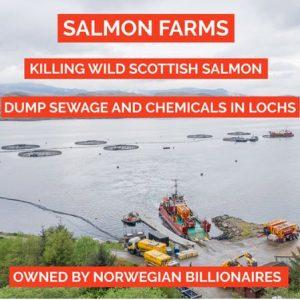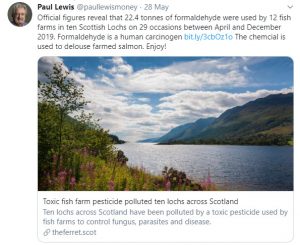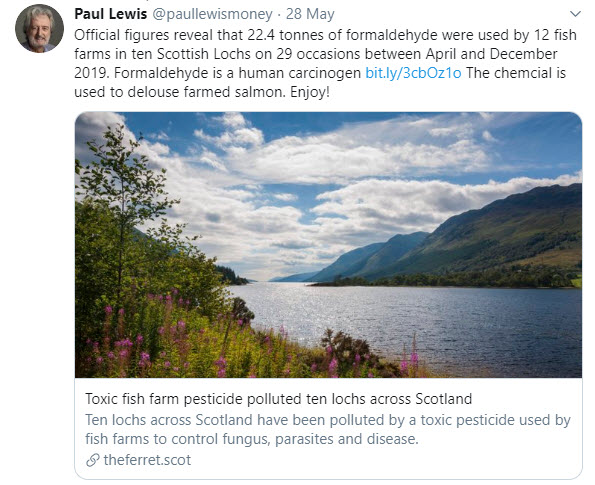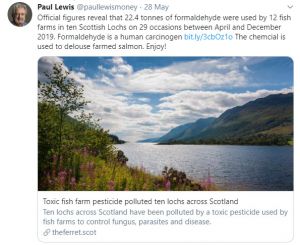Evidentially: It’s been a while since I referred to anti-salmon farming campaigner Corin Smith. He recently posted the following:
ACTION | Rise Up. We want our wild salmon and coastlines back from salmon farmers. What are we doing to make it happen? In the last two years we’ve achieved a huge amount and there’s no doubt we’re crushing the salmon farm spin, but we need to do more.

Mr Smith describes his ‘organisation’ as an Environmental Conservation Organisation’ and until this week he has avoided saying anything about wild salmon but in addition to the above he has posted the following image on his Facebook page:

In this he suggests that salmon farming kills wild Scottish salmon. As regular readers will know I have been privately researching this subject for over ten years and I have yet to see any conclusive evidence that salmon farming is responsible for the decline of wild salmon stocks in Scotland. There is research from Ireland and Norway that indicates that the mortality of migrating salmon due to sea lice is between one and two percent. I appreciate that Mr Smith will disagree as the data has been disputed for years, mainly because it doesn’t fit in with the accepted wild fish narrative. However, whether the figure is 1-2% or a 50% difference between treated and untreated, the actual numbers show that mortality from sea lice is very low. Marine Scotland Science tried to replicate the Irish and Norwegian work using fish from the River Lochy, but no fish returned at all confirming that the problem really lies elsewhere.
However, I am always open to be persuaded otherwise and I have written to Mr Smith to ask to see the evidence he bases his claim on. I am also realistic that Mr Smith is reluctant to engage directly so I have suggested that he uses his photographic and video skills to clarify his claims and hopefully move away from the circumstantial evidence that is most widely cited.
I have suggested a video because during the Covid crisis, such visual formats have come into their own. As it happens, I have also been working on a video presentation too. One of the problems about farmed-wild interactions is that many anglers have only heard one side of the debate. For example, the angling press are not interested in publishing explanations as to why salmon farming is not to blame for wild fish declines. I am hoping to develop a series investigating various aspects of the debate but the first is an updated view of what happened to Loch Maree.
The video can be viewed at: https://youtu.be/JmAI7ham9fI
I very much hope that it is of interest and would ask that if anyone knows anyone who is a keen salmon and sea trout angler then they forward on the link. The Salmon Interactions Working Group has considered the interactions between salmon farming and wild fish but did not actually aim to resolve whether there is an impact or not and how big it is if there is. After forty years, this is an issue that needs to be resolved once and for all. We need to have a proper debate rather than a slanging match.
I welcome any feedback, especially from the wild fish sector instead of the usual wall of silence.
Re: but: Last week, the following comment was posted on Twitter. It was post by awarded winning financial journalist Paul Lewis, who is most well-known for his Moneybox programme on BBC Radio 4. Although it is disappointing, that such an established and recognised journalist is tweeting negative stories about the salmon farming industry, what it is even more frustrating is that Mr Lewis’ post is factually incorrect.

Sadly, it seems that no attempt was made to correct Mr Lewis’ error but whether Mr Lewis is corrected is not the main issue. What is of concern is that Mr Lewis has almost 134,000 followers who have received the same factually incorrect message.
My understanding is that the salmon farming industry has taken the decision not to actively correct or rebut facts on Twitter. This is because most of the misleading and negative messages about salmon farms emanate from a small number of keyboard warriors who aren’t interested in engaging or discussing the issues. I can understand the industry’s reluctance because my own experience is this minority prefer to respond with abusive comments rather than constructive discussion. They have their narrative and are not willing to hear anything else.
The problem is that whilst those in the industry recognise this strategy, others might not. Hence, the Ferret story is derived from information and spin provided by this minority, which then finds its way to a much larger audience than it either warrants or deserves and of course, along the way, the original story gets twisted so that it is now factually incorrect. I saw another tweet this week which also was repeated by a much more public figure with over 120,000 followers. It is not surprising that over the years so much negativity about salmon farming has been allowed to develop.
Surely, it is now time for the industry to fight back. Of course, the industry should be publicising the good news, but it also should be rebutting every negative story that appears whether it is on Twitter, in other social media or in the mainstream press. One of the main reasons is that there are so many negative perceptions about salmon farming is because most of the negative stories are rarely challenged.
However, it is possible to obtain a positive result when the nonsense is challenged. At the end of April, ‘Varsity’ the Cambridge University newspaper (online and with a distribution of 10,000 paper copies), published an article about the horrors of salmon farming. I didn’t keep a copy so I cannot quote it exactly but at one point the author wrote about sea lice saying that he was sure that other readers had shared the same experience as him and that on at least a couple of occasions he had bitten into a smoked salmon sandwich only to find a sea lice writhing around inside.
![]()
This story was wrong on so many levels and for once I took the trouble to write to the editor to point out that whilst some negative stories written about the salmon farming industry could be based on an element of truth, this particular story that appeared in the Varsity newspaper was just a fantasy and that the salmon in the smoked salmon would have been brined, smoked, sliced from the skin and vacuum packed. As sea lice are an external parasite, the chances of the writer of the article eating a live one was just impossible. The article was subsequently removed. The link no longer works.
It’s a shame that this story couldn’t have been stopped from being printed in the first place but that didn’t happen. It could be argued that if every story was rebutted with a full explanation and sent to every journalist and editor who might publish such stories then eventually, they might get the message and start to check the facts before any story is published.
Blue book: About a month ago, the Atlantic Salmon Trust published a new book in their ‘Blue Book’ series. This was a report of a meeting held in September last year about fish tracking.
Fish tracking projects are the big ‘new’ thing in wild fish conservation. It’s not actually new but modern technology has improved the ability to track the movements of migrating fish in both fresh and sea water. It does however seem that now this improved technology is available, there is a belief that it can produce answers and thus should be used wherever possible.
The most high-profile study to use this technology is the Missing Salmon Project around the Moray Firth. This has so far tracked 850 tagged smolts down serval river systems around the Moray Firth and out into the sea in an attempt to understand why so many disappear. The results of the first year of the study found that about 50% of the smolts were lost in the river and a further 15% as they start their marine journey. The second year of the project has been put on hold, but the aim is to understand why the smolts go missing, Is it because of general river conditions, predation or just a fact of life.
There is a lot of investment of time and money in these tracking projects and there are so many variables that any real conclusions may yet be years away. This is not the first such tracking project as smolts have been tagged in the River and tracked down to Aberdeen Harbour. The mortality of fish from the upper river was up to 70% and much less when tagged lower down the river. However, whilst predation is blamed on the high mortality, the study was considered inconclusive. The question is why will the Moray Firth project be any different? It could even be suggested that such large, expensive tracking projects are just a distraction. They look good but will achieve little especially at a time when stocks continue to decline.
If the Moray Firth project might be thought to be a distraction, then the proposal to invest in a west coast tracking project makes no sense at all. I appreciate that the bulk of funding is being provided through a Marine Scotland scheme but surely the money could be better used to help solve some of the issues affecting the big east coast rivers, where the bulk of the salmon are caught.
The west coast study reminds me of the Marine Scotland Science sea lice study mentioned earlier. It was simply a repeat of studies done elsewhere. If there are any answers to come out of the Moray Firth tracking project, it is likely that they will apply equally to west coast rivers. Unfortunately, organisations like the Atlantic Salmon Trust are fixated on salmon farming and think that tracking fish on the west will come up with some form of proof to justify this study. Sadly, this is unlikely but if they are so convinced, then hopefully they will revert with a full explanation and commentary as to why what I have said in my video is incorrect.
It is only necessary to look at the original questions they posed when they launched the Moray Firth Tracking Project. This can be found at: https://atlanticsalmontrust.org/missing-salmon-project-your-questions-answered/

Of course it also worth remembering that the AST’s research director Professor Ken Whelan was involved in some of the original research in Ireland which looked at problems affecting wild sea trout and concluded that the cause must be a nearby salmon farm. With hindsight, there were other events taking place which might have caused the problems with sea trout. The observations made at the time don’t ever seem to have been repeated despite an expanded salmon industry. I will look again at these events another time.
Talking Salmon: A new twitter account has attracted the attention of the anti-salmon farming twiterati. The assumption they seem to have made is that I am behind this account.
I would like to state categorically that I am not. I am more than happy to put my name to anything I say and don’t need to hide behind an anonymous account. Sadly, the same cannot be said for these keyboard warriors who hide behind their PC screens and feel they can say whatever nonsense they like without being identified.
I have said it before but if they feel so strongly about the impacts of salmon farming on wild fish then stand up and make your views known but equally be prepared to defend them rather than dismiss anything you don’t like without recourse.
The critics seem to find it hard to get their heads round the fact that there are many people out there who have similar view to mine. This could just be one of those who simply got fed up with the constant nonsense from these anonymous accounts.


